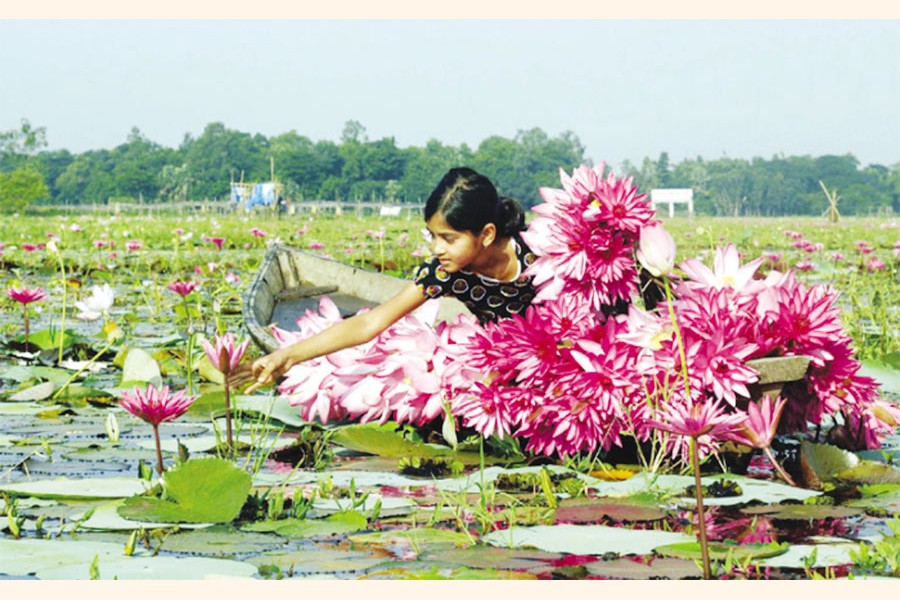Right now Sylhet is passing a nightmarish time on account of the worst floods the region has ever experienced. As many as three bridges have collapsed due to strong force of rushing waters. In this hilly region floodwaters, for reasons understandable, are likely to gain greater momentum than in plain lands.
Climate change is making its presence felt in more ways than people have traditionally been familiar with. But are we aware of the phenomenal changes that have taken in this Gangetic basin in a geomorphologic sense over the decades? Vast swathes of low lands in Barishal and Faridpur in the 50's of the last century barely came out of water for two to three months, allowing farmers to cultivate Aus and Aman paddy. Seeds of the two types were sown, not planted, at the same time after ploughing lands with bullocks.
The two types of paddy plants grew without irrigation because the crop field hardly lost its moisture. Then there were rains enough and by early Ashad, invariably the entire area started experiencing submersion. Rivers swelled and their tributaries brought in water at times more than was required. By Shrabon and Bhadra not only did the croplands go under water eight to twelve feet deep but even homesteads turned into tiny islands. With their long stalks, paddy plants kept their heads above the water level by as much as one foot to two feet.
The inundation was common and part of life. In fact, boats were the main transports and vast areas did not even have a road to walk on. When floods did occur, even the homesteads went under water and people had to construct a bamboo bridge between the dwelling house and kitchen which in most cases were at some distance across the lawn. So frequent were such inundations that villagers considered those phenomena part of life and were resilient enough to cope with the vagaries.
Of the two crops, Aus ripened in late Ashad or early to middle of Shrabon. If there were early floods, Aus harvest suffered because its stalks could not keep up with the rising levels of water. But Aman paddy grew taller and was not usually damaged unless of course floods were of extreme nature and prolonged. Strangely, both types of paddy were cultivated on the same plot and this did not cause competition for space between the two.
It is a lost world now. Today's children cannot in their wildest imagination come close to forming a picture of the villages their grandpas and grandmas in the 40's, 50's and 60's lived in. The transformation has been phenomenal with vans, auto-rickshaws, motorbikes and even cars now plying on carpeted roads that run to connect villages to the upazilas or other commercial centres.
No, people were not affluent then. At times they had to face severe food shortage because of crop losses. But they were compensated to a degree by natural resources such as fish, vegetables and fruits. Villagers usually did not have to purchase essentials other than salt, spice, lentils, cooking oil and of course kerosene. The last item was a must because there was no electricity. As for cooking oil, lentils and milk, the better-off families had their own arrangement for growing or making provision for. They had designated plots usually those of higher area for growing sesame seeds, mustard seeds, flax (tishi) seeds and rapeseeds for their yearly requirements of cooking oil.
A whole range of Aman paddy with beautiful names was cultivated. The Aus and Deegha types of paddy had been in fact an interim arrangement before the main crop Aman was harvested in Agrahayan and Poush. It was time when people did not know about the use of chemical fertiliser and insecticide. So, the taste of rice, fish and vegetables remained original and pure.
True, floodwater wreaked havoc with crops but they also helped increase the fertility of lands. There were small delights all around. A few species of fish came close to the newly submerged landmass where earthworms came out and the fish had their bellyful of a feast. The hunter of all hunters also took advantage of the vulnerability of the greedy fish to spike them with what is called fishing 'teta' comprising three to nine thinnest of iron bars or skewers. People could fish at the easiest of efforts, so abundant were this rich source of protein.
Both local and migratory birds came in flocks. They made a heavenly sight when they descended on expansive fields full of water lilies. Eagles, now rare indeed, loved to build their nest close to homesteads. They announced, without fail, time at night for villagers. In Ashad or Shrabon, there was nothing to be surprised if a cormorant couple quacked incessantly to break the silence from not too far in the thick paddy plants in the vicinity of a village. No amount of money can return those times of simple and pure joy.

- Sunday, 17 November 2024 |
- Today's FE |
- e-Paper |
- Beta Website

